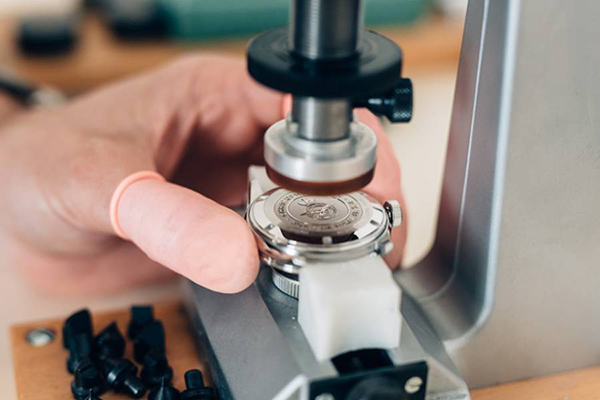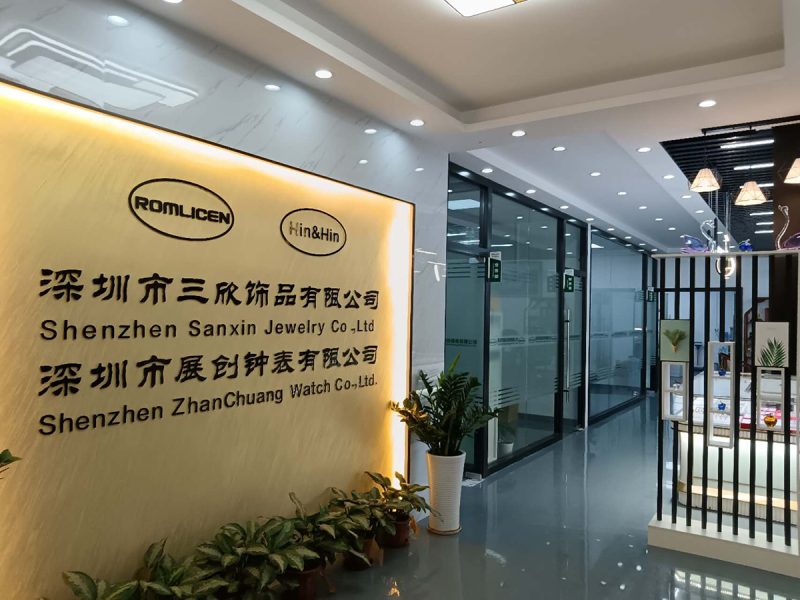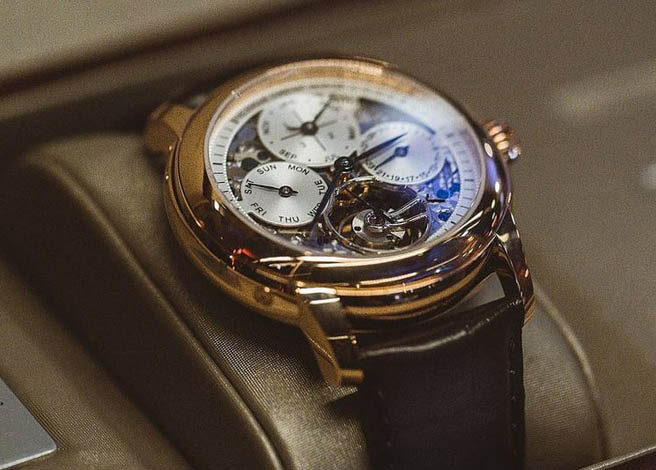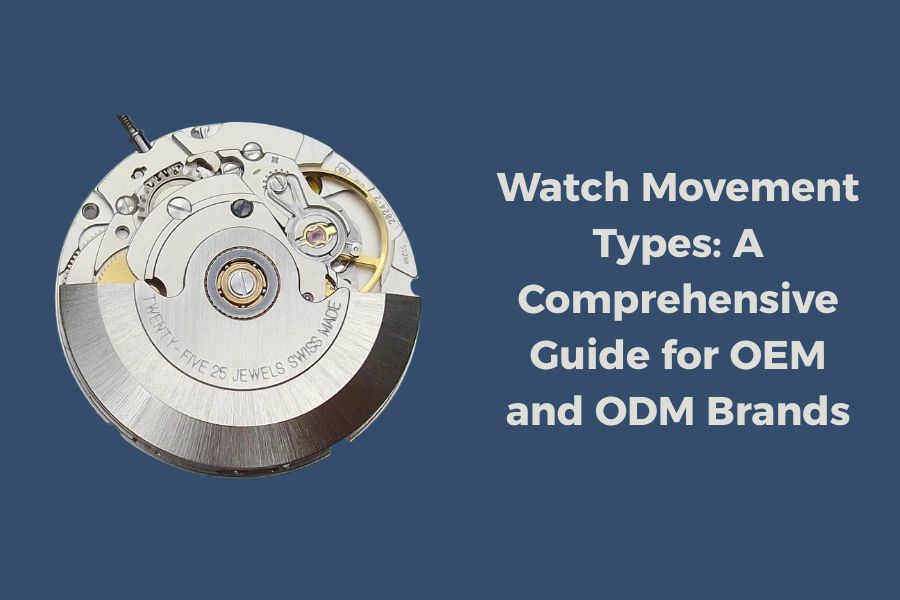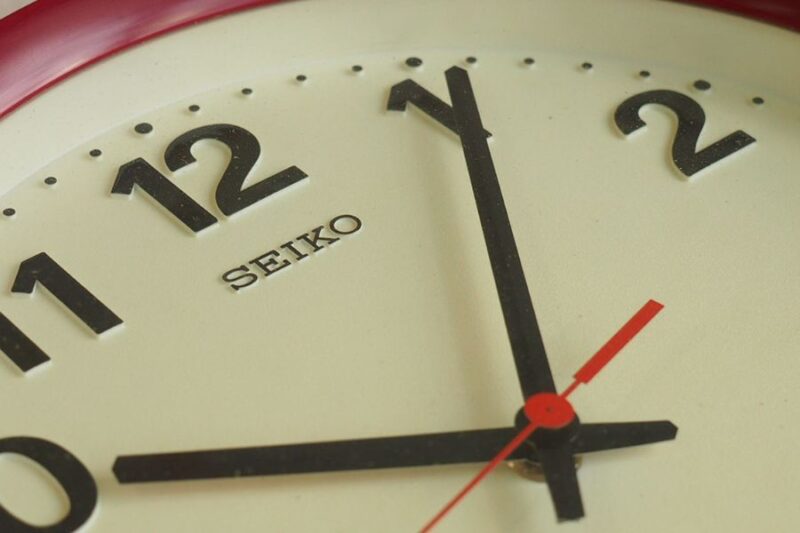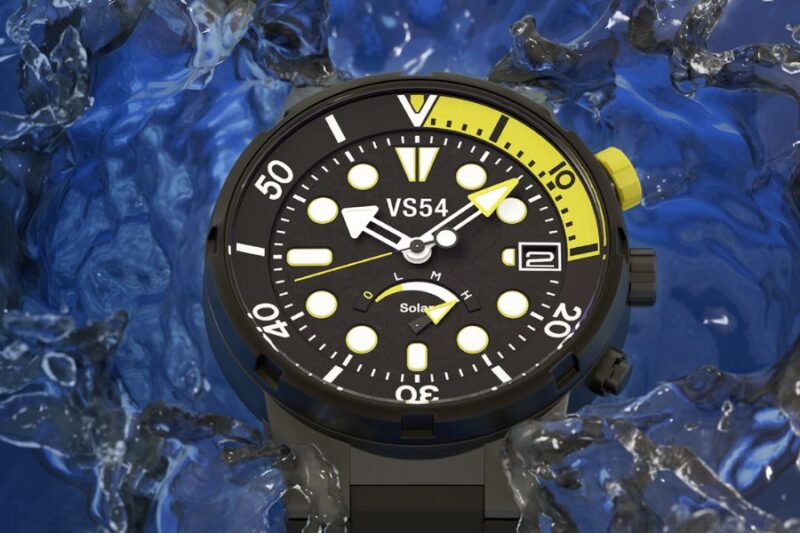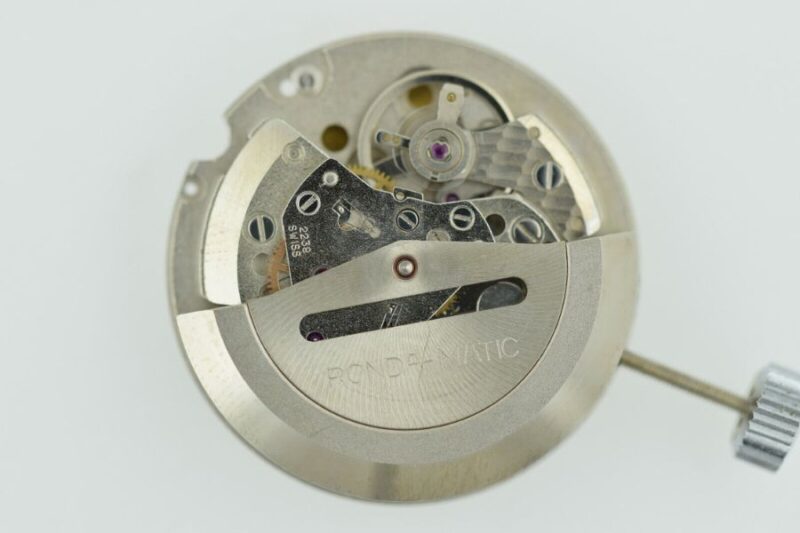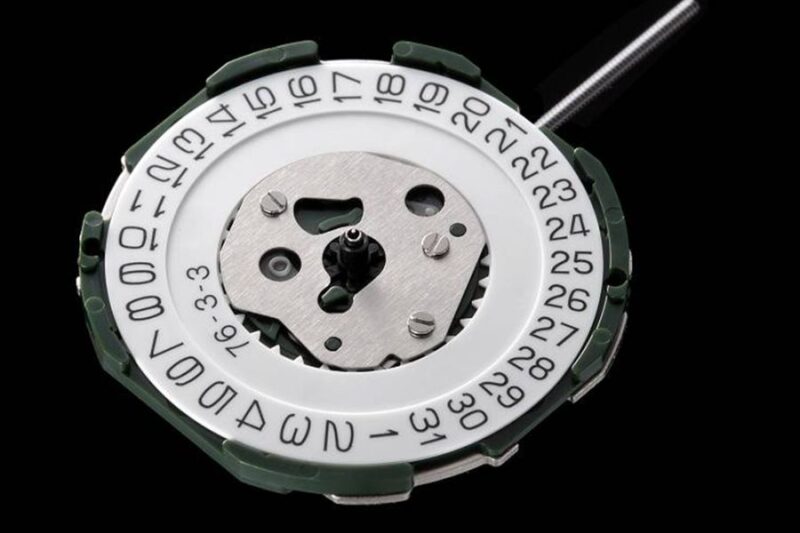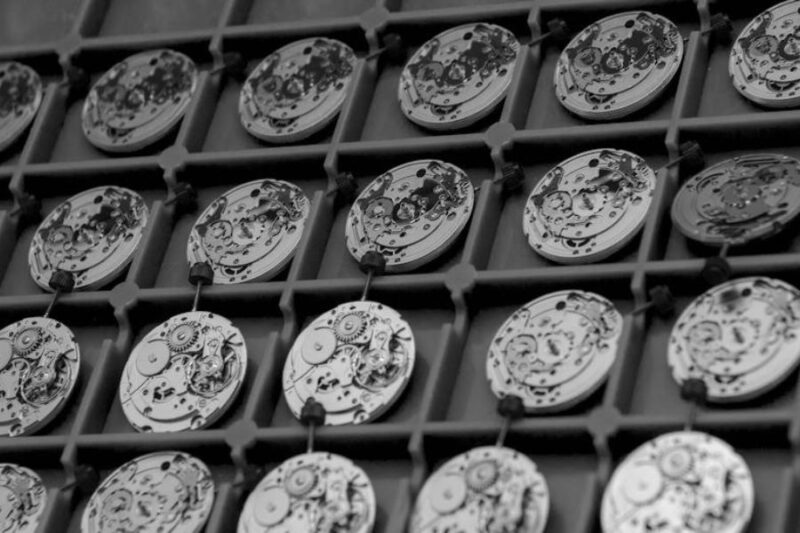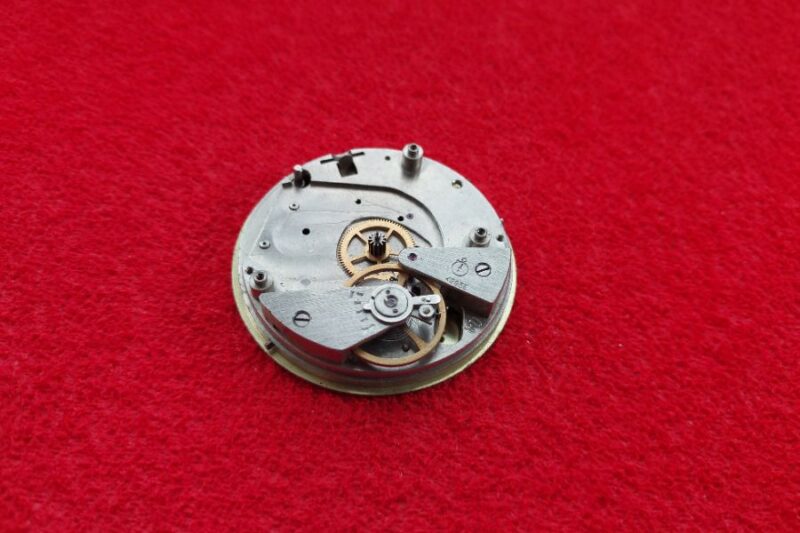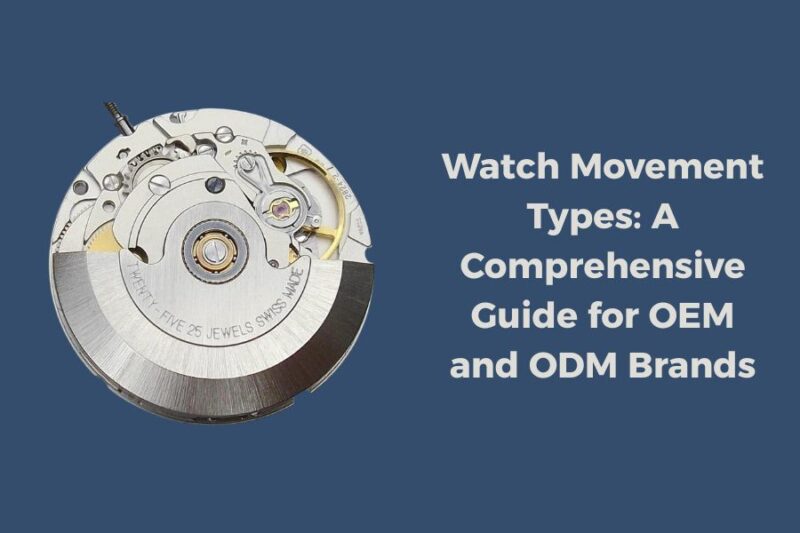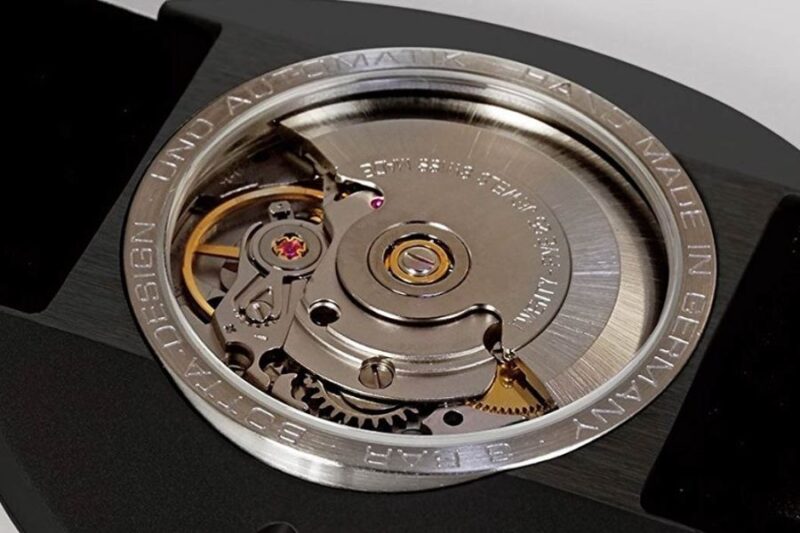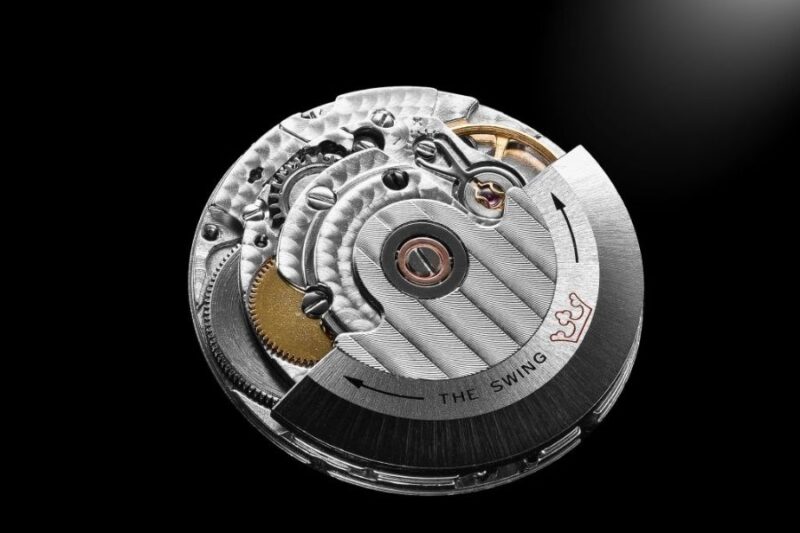Table of Contents
Introduction
What makes a watch tick? At its core, the answer lies in the watch movement—the intricate mechanism that powers every second, minute, and complication. For OEM and ODM brands, selecting the right watch movement types is more than a technical choice; it’s a strategic decision that defines your timepiece’s quality, appeal, and market position. Whether you’re crafting a minimalist fashion watch or a luxury dive watch, the movement you choose shapes your brand’s story. In this guide, we’ll explore the main watch movement types—quartz, mechanical, and automatic—along with expert insights to help you elevate your custom watch design. Let’s dive into the heart of watchmaking.
What Are Watch Movement Types?
The watch movement, often called the “engine” of a timepiece, is the mechanism that drives the hands and powers any complications, like date windows or chronographs. For OEM and ODM brands, understanding watch movement types is crucial to creating timepieces that align with your vision and market goals. Broadly, movements fall into three categories: quartz, mechanical, and automatic. Each offers distinct advantages, from precision to prestige, depending on your brand’s needs. Let’s break down what makes these watch movement types unique and how they shape your custom watch design.
How Watch Movements Work
At its core, a watch movement keeps time by regulating energy. Quartz watch movements rely on a battery and a vibrating quartz crystal to maintain accuracy, making them reliable and low-maintenance. Mechanical watch movements, on the other hand, use a wound spring and a series of gears, powered purely by craftsmanship, offering a traditional appeal. Automatic watch movements combine mechanical artistry with convenience, self-winding through the wearer’s motion. Each type serves different purposes, from affordable everyday watches to high-end collector’s pieces.
A Brief History of Watch Movements
Watch movements have evolved dramatically since the 17th century, when mechanical movements dominated early pocket watches. The 1970s marked a turning point with the “quartz revolution,” introducing affordable, precise quartz watch movements that reshaped the industry. Today, brands choose movements based on heritage, functionality, and market positioning. Whether you opt for a Swiss ETA, a Japanese MIYOTA, or a Chinese Seagull movement, understanding their origins helps you craft a timepiece that resonates with your audience.
Quartz Watch Movements: Precision and Affordability
For OEM and ODM brands aiming to deliver reliable, cost-effective timepieces, quartz watch movements are a go-to choice. Known for their accuracy and minimal maintenance, quartz movements power a wide range of watches, from sleek fashion pieces to everyday essentials. As part of the broader watch movement types, quartz offers unmatched precision at a price point that suits mass-market and entry-level brands. Let’s explore how quartz movements work and why they’re a smart pick for your custom watch line.
How Quartz Movements Work
Quartz movements operate with remarkable simplicity. A battery sends an electric current through a quartz crystal, causing it to vibrate at a precise frequency (32,768 times per second). These vibrations regulate the movement of the watch hands, ensuring near-perfect timekeeping. Unlike mechanical or automatic movements, quartz requires no winding and is highly resistant to external factors like temperature changes. This reliability makes quartz watch movements a favorite for brands prioritizing consistency and ease of use.
Why Choose Quartz for Your Brand?
Quartz movements shine when affordability and scalability are key. They’re ideal for minimalist designs, fashion-forward watches, or budget-conscious collections that don’t compromise on quality. For example, Japanese brands like MIYOTA and EPSON offer robust quartz movements used by global watchmakers for their durability and precision. Quartz is also low-maintenance, appealing to customers who want a grab-and-go timepiece. By opting for an affordable watch movement like quartz, your brand can cater to a broad audience while maintaining healthy margins. Curious about the history of quartz? Check out Hodinkee’s take on the quartz revolution for a deeper dive.
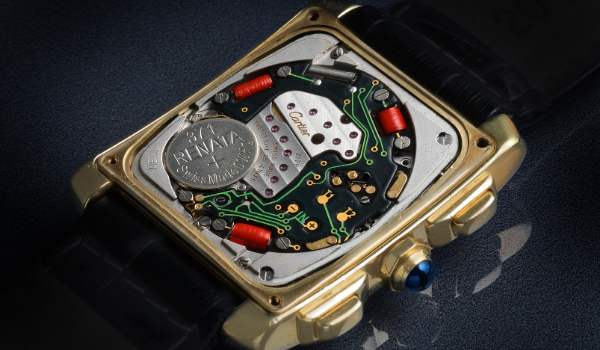
Mechanical Watch Movements: The Art of Craftsmanship
For OEM and ODM brands crafting timepieces with timeless appeal, mechanical watch movements embody the essence of traditional watchmaking. Unlike their quartz counterparts, these movements rely on intricate craftsmanship, offering a sense of heritage that resonates with collectors and luxury enthusiasts. As a cornerstone of watch movement types, mechanical movements elevate custom watches to an art form, blending precision with prestige. Let’s delve into how they work and why they’re perfect for your high-end brand.
Understanding Mechanical Movements
A mechanical watch movement is powered by a tightly wound spring, which releases energy through a series of gears and springs to drive the watch’s hands. Each tick is a testament to centuries-old engineering, with no batteries or electronics involved. These movements require regular winding—typically every 24 to 48 hours—adding a ritualistic charm for wearers. Swiss brands like ETA and Sellita are renowned for their mechanical calibers, offering reliability and customization for premium OEM projects.
When to Opt for Mechanical Movements
Mechanical movements are the heart of luxury and heritage-focused watches. They’re ideal for brands targeting collectors, connoisseurs, or markets that value exclusivity. Think limited-edition dress watches or robust dive watches with intricate complications. The tactile beauty of a mechanical movement, often showcased through a transparent caseback, adds a storytelling element to your brand. For example, Romlicen’s OEM Watch Services can integrate a Sellita SW200 into your bespoke design, ensuring sophistication and durability. Choose mechanical for watches that feel like heirlooms.
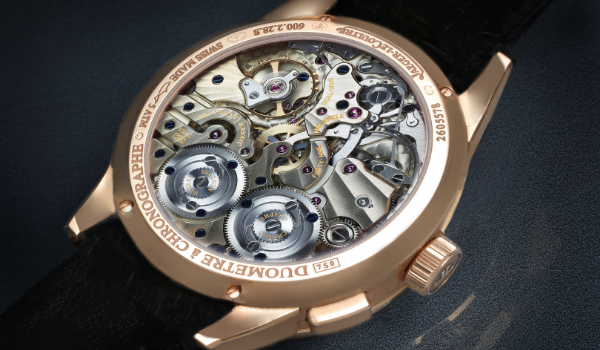
Automatic Watch Movements: The Best of Both Worlds
For OEM and ODM brands seeking a balance between craftsmanship and convenience, automatic watch movements offer an ideal solution. Combining the artistry of mechanical movements with the practicality of self-winding technology, automatics are a standout among watch movement types. They appeal to customers who crave the prestige of a mechanical watch without the daily winding ritual. Let’s explore how automatic watch movements work and why they’re a versatile choice for your custom watch brand.
How Automatic Movements Function
An automatic watch movement, also known as a self-winding watch movement, harnesses the wearer’s wrist motion to power the watch. A rotor—a semi-circular piece of metal—pivots with movement, winding the mainspring to store energy. This eliminates the need for a battery or manual winding, as long as the watch is worn regularly. Brands like Seiko and Hangzhou produce reliable automatic calibers, such as the Seiko NH35, known for their durability and smooth performance in mid-range timepieces.
Benefits for Custom Watch Brands
Automatic movements are a sweet spot for brands targeting the everyday luxury or sport watch market. They offer the sophistication of mechanical craftsmanship with user-friendly functionality, making them perfect for dive watches, pilot watches, or casual dress pieces. For instance, integrating a Hangzhou 7001 automatic movement into your design can elevate your brand’s appeal without breaking the bank. Explore Romlicen’s Watch Design Services to create a timepiece that blends style and substance. Choose automatics for watches that effortlessly bridge tradition and modernity.
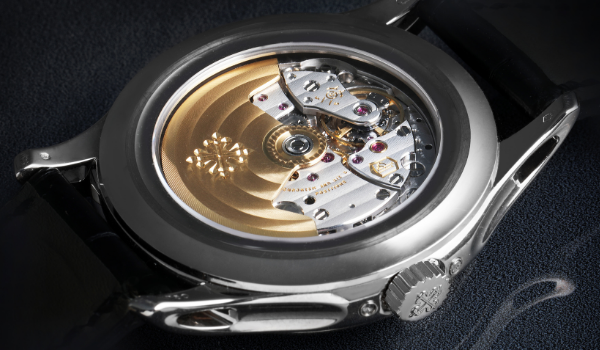
Swiss, Japanese, or Chinese Movements: Which to Choose?
When selecting watch movement types for your OEM or ODM watch brand, the origin of the movement—Swiss, Japanese, or Chinese—plays a pivotal role in defining quality, cost, and brand perception. Each region offers distinct advantages, from Swiss prestige to Japanese reliability and Chinese affordability. Understanding these differences empowers you to align your choice with your target market and brand vision. Here’s a breakdown to guide your decision.
Swiss Watch Movements (ETA, Sellita, Ronda): Swiss movements are synonymous with luxury and precision. Brands like ETA and Sellita power high-end watches with calibers like the ETA 2824, known for accuracy and customization options. Ideal for premium or heritage-focused brands, Swiss movements carry a global reputation that justifies a higher price point. However, they come with elevated costs, making them best for luxury markets.
Japanese Watch Movements (MIYOTA, Seiko): Japanese movements strike a balance between quality and affordability. MIYOTA’s 9015 and Seiko’s NH35 are favorites for their durability and versatility, powering everything from dive watches to dress pieces. These movements suit mid-range brands aiming for reliability without the premium Swiss price tag, appealing to a broad audience.
Chinese Watch Movements (Seagull, Hangzhou): Chinese movements, like Seagull’s ST2130 or Hangzhou’s 7001, have gained traction for their affordability and improving quality. They’re perfect for budget-conscious brands or entry-level collections, offering solid performance at a fraction of the cost. As Chinese manufacturers innovate, these movements are increasingly viable for value-driven markets.
Choosing the right movement depends on your brand’s positioning, budget, and audience. A luxury brand might opt for a Swiss Sellita, while a lifestyle brand could thrive with a Japanese MIYOTA.
Quick Comparison: Swiss, Japanese, and Chinese Movements
Choosing the right watch movement types can be streamlined with this detailed comparison of Swiss, Japanese, and Chinese movements. From luxury to budget lines, Romlicen’s OEM Watch Services ensures your brand finds the perfect fit.
Movement Origin | Key Brands | Price Range | Best For | Accuracy | Durability/Maintenance |
|---|---|---|---|---|---|
Swiss | ETA, Sellita, Ronda | $100-$500+ | Luxury dress watches, chronographs | ±5-15 sec/day | High durability, service every 5-7 years |
Japanese | MIYOTA, Seiko, EPSON | $30-$150 | Dive watches, pilot watches | ±10-20 sec/day | High durability, minimal servicing |
Chinese | Seagull, Hangzhou | $10-$50 | Fashion watches, budget sports | ±15-30 sec/day | Moderate durability, low maintenance |
How to Choose the Right Movement for Your Brand
Selecting the perfect watch movement types for your OEM or ODM watch brand is a strategic step that shapes your product’s identity and market success. Whether you’re designing a luxury timepiece or an affordable everyday watch, the right custom watch movement aligns with your brand’s vision, budget, and audience expectations. Here’s how to make an informed choice that elevates your timepieces.
Align with Brand Identity: Your movement should reflect your brand’s story. For a luxury brand targeting collectors, a Swiss Sellita SW200 mechanical movement adds prestige. For a trendy, accessible brand, a MIYOTA quartz movement offers reliability at a lower cost. Ask: Does the movement enhance your brand’s narrative?
Understand Your Audience: Consider who’s buying your watches. Collectors value the craftsmanship of mechanical or automatic movements, while casual buyers prioritize the low-maintenance appeal of quartz. For example, Romlicen recently helped a client launch a dive watch line using a Seiko NH35 automatic movement, striking a balance for sporty, mid-range consumers.
Balance Cost and Quality: High-end Swiss movements elevate perceived value but increase costs. Chinese movements like Seagull’s ST2130 provide affordability without sacrificing performance for entry-level lines. Evaluate your budget against the movement’s market impact.
Partnering with an experienced manufacturer ensures you choose a movement that fits seamlessly into your design. Explore Romlicen’s Watch Design Services to craft a timepiece that resonates with your audience and stands out in the market.
Conclusion
Choosing the right watch movement types is the heartbeat of your custom watch brand. From the precision of quartz to the craftsmanship of mechanical and the versatility of automatic movements, each option offers unique benefits tailored to your market and vision. Swiss, Japanese, or Chinese movements further refine your choice, balancing quality, cost, and prestige. By aligning your movement with your brand’s identity and audience, you create timepieces that resonate and endure. Ready to craft your signature watch? Contact Romlicen’s OEM Watch Services today to explore expert solutions for your next collection.
Frequently Asked Questions
The primary watch movement types are quartz, mechanical, and automatic. Quartz movements use a battery for precision, mechanical movements rely on a wound spring for craftsmanship, and automatic movements self-wind via wrist motion. Each suits different brand goals, from affordability to luxury.
Quartz watch movements are the most accurate, thanks to their crystal-regulated vibrations (32,768 times per second). They outperform mechanical and automatic movements in timekeeping, making them ideal for brands prioritizing reliability in their custom watch brand.
For luxury watches, mechanical or automatic movements, like Swiss ETA or Sellita calibers, are preferred. Their intricate craftsmanship and heritage appeal to collectors. Romlicen’s OEM Watch Services can integrate these for premium designs.
It depends on your brand’s focus. Automatic movements offer a blend of mechanical artistry and convenience, ideal for mid-to-high-end watches. Quartz provides superior accuracy and affordability, perfect for mass-market lines. Consider your audience when choosing watch movement types.
Align the movement with your brand identity, audience, and budget. Luxury brands may opt for Swiss mechanical movements, while affordable lines suit Chinese quartz. Evaluate quality, cost, and market fit to ensure your timepiece stands out.
Quartz movements, like MIYOTA or EPSON, typically last 2-5 years before needing a battery replacement. With proper maintenance, the movement itself can function for decades, making them a durable choice for watch movement types.
Modern Chinese movements, such as Seagull ST2130, offer impressive reliability for their cost. They’re ideal for budget-conscious custom watch brands and have improved significantly in quality over the past decade.
ETA and Sellita are Swiss brands with similar quality. ETA is older and widely used, while Sellita offers cost-effective alternatives like the SW200. Both are excellent for luxury watch movement types.
Related Reading
- Understanding Swiss Watch Movements: Precision in Watchmaking
- A Comprehensive Guide to Chinese Watch Movements
- What is a Japan Movt Watch? A Complete Guide to Japanese Movement Timepieces
- Ticking Styles: Exploring the Different Type of Watches Movement
- Parts of a Watch: A Comprehensive Guide to Watch Anatomy
- How to Choose the Perfect Movement for Your Custom Automatic Watch
- The Difference Between Quartz and Mechanical Movements in Custom Watches
- Exploring the Benefits of Swiss, Japanese, and Chinese Watch Movements
